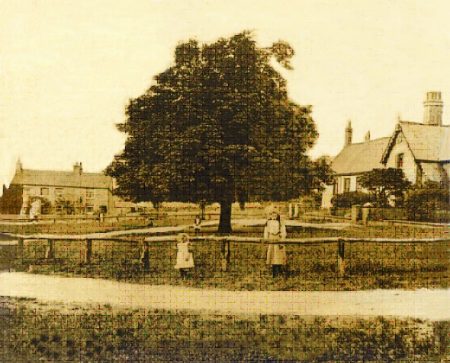By local history enthusiast Adrian Kerton.
From the coins spilling from a pot in a stream, that was broken by a lad throwing a stone, and from excavations around the parish, particularly on the Royal Estate at Sandringham Road, we know the Romans had a presence here. The coins were reported as those of Constantine the Great.
We know from the Domesday book that the population of Stoch was 8 villagers, 3 smallholders, 4 slaves and one priest. Its value to the lord in 1066 was £6 and in 1086 £8. As Stoch had a priest, it may have had a wooden Saxon church, perhaps on the site of the present day St Michael’s.
In Saxon times, Stoke Gifford was held by the thegn (a Saxon nobleman) Dunnne, (Dunne tenuit) until William the Conqueror invaded in 1066 who then gave lands to those who had helped him. Osbern Giffard, from the Normandy town of Longueville-le-Giffard, was given Stoch, hence we have Stoke Gifford. The three manors of Stoke Gifford were Stoke, Walls and Harry Stoke, though Harry Stoke was owned by the Lords of Filton and wasn’t part of the current parish until the 16th century when the Berkeleys bought it.
The Giffards moved away from the parish to Brimsfield where they built a castle, were notorious, and finally Sir John rebelled against King Edward and was hung, drawn and quartered at Gloucester when his lands passed to the Berkeleys and eventually by marriage to the Beaufort family who sold the village in 1915 to pay death duties.
In Medieval times the centre of Stoke Gifford was at the top of the village centred around Rock Lane. Excavations at Parsonnage fields by James Russell revealed a large farmhouse over 70 feet long, with at least three ground floor rooms and a projecting ‘garderobe’ or privy block on the west side. It probably covered the site of the supposed Giffard Manor House. It seems to have been demolished around 1600. The last of the medieval buildings to survive was probably the Parsonage, which stood in a patch of ground called ‘Glebe’ in the southeast corner of the field.
An old map from the early 18th century contains some illustrations of the houses in the village at the time, which from some existing buildings, appear to be accurate.
It seems life carried on pretty much as usual as an agricultural community until the arrival of the railways, when new housing came to the village. Later on, Little Stoke expanded from being a small hamlet to provide housing for the aircraft industry. Housing gradually expanded until the large new estates arrived in the 1970s.
Those who liked a drink had to move from the Portcullis Inn on North Road (now Silverdale ) to the Beaufort Arms on the site of the old village pound where the hunt often met.
Despite the arrival of supermarkets, the post office shop continued to provide local produce to its loyal band of customers until it closed due to ill health.
The image that probably most associate with Stoke Gifford is The Green with the old school room and houses built in 1863 by the Beauforts.
The old post office can be seen on the left of the picture. The tree has gone but The Green is still regarded as the centre of the modern village.
In future articles, we will focus on specific aspects of the history including Harry Stoke, Little Stoke and the general aspects including education.
• More information: The History of Stoke Gifford, edited by Adrian Kerton
Local history timeline
- AD 270 The Romans arrive
- 1066 Duns the Saxon Lord loses his lands to William The Conqueror
- 1294 The of endowment of the vicarage of Stoke Gifford from the Bishop of Worcester
- 1299 A survey of the tenants is taken
- 1322 John Mautrauers takes ownership of much of the village and many surrounding lands, including the Manor of Walls
- 1334 The Berkeleys gain Stoke Gifford
- 1770 Elizabeth Berkeley duchess dowager of Beaufort gains the manor
- 1863 The Duke of Beaufort endows the village with a school
- 1903 The railway is extended to include Stoke Gifford
- 1915 Stoke Gifford is sold by the Beauforts to pay death duties
Photo: View of The Green in Stoke Gifford ‘village’. The old post office can be seen in the left of the picture.
This article originally appeared in the October 2018 issue of the Stoke Gifford Journal news magazine (on page 7). The magazine is delivered FREE, EVERY MONTH, to over 5,000 homes in Stoke Gifford, Little Stoke and Harry Stoke. Phone 01454 300 400 to enquire about advertising or leaflet insertion.





Hmm no mention of any role in the slave trade?
Whitewashing?
@Mary, Thanks for your comment. You might wish to contact the author of the article, Adrian Kerton, to discuss.